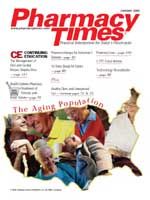Publication
Article
Pharmacy Times
New Treatments on the Way for Diabetes—Part 2
Author(s):
Traditionally, insulin has beenavailable only as a more-thanonce-daily subcutaneous injectionfor patients. Insulin glargine(Lantus) is a synthetic insulin developedthat simulates 24-hour basalinsulin production, allowing certainpatients with type 2 diabetes to reducetheir insulin injections to just 1 a day.It has now become commonplace totreat patients with a combination ofinsulin and 1 or more oral hypoglycemicagents. Many patients, however,still search for a needleless alternativeand are willing to take acombination of up to 3 oral hypoglycemicmedications to avoid theneedle stick involved with insulinadministration. The development ofinhaled insulin may help increasepatient acceptability of necessaryinsulin treatment.
At the annual meeting of theAmerican Diabetes Association, severalpreliminary studies on inhaledinsulin were presented. Exubera is afine, dry-powder, rapid-acting insulinthat is under development. Some studiesindicate that it may be at least aseffective as injected insulin and maybe superior to combination oral therapyfor diabetes. One study included470 patients who had type 2 diabetesthat was uncontrolled on metformintherapy alone. Two groups were randomizedto receive either adjunctiveinhaled insulin or glyburide. Amongpatients with a baseline hemoglobinA1C (HgA1C) reading of >9.5%, thosein the inhaled-insulin group demonstrateda 2.9% reduction in HgA1C,compared with a 2.5% reduction experiencedby the glyburide group. Thedecline in HgA1C in patients with abaseline reading of <9.5% was similarin the 2 treatment groups.
Other summaries of phase 3Exubera studies were presented aswell. In one 52-week study, a group of336 patients were treated with adjunctiveinhaled insulin, and a secondgroup of 291 patients were treatedwith combination oral therapy only.Decreases from baseline HgA1C weresimilar in the 2 groups, with an averagedecrease to 7.6% and 7.8% in thecombination-inhaled-insulin groupversus the combination-oral-therapygroup, respectively. Episodes of hypoglycemiawere similar in both treatmentgroups. Measured forced expiratoryvolume in 1 second was loweredto a greater extent in the Exuberagroup at both 24 and 52 weeks. Theclinical significance of this finding isnot known at this time. Additionalsafety testing is ongoing to determinewhether any long-term compromiseof pulmonary function or damage tolung tissue will be of concern.
The presence of insulin antibodieswas noted to a greater extent in onestudy in patients using inhaled insulinversus traditional injected insulin.Although glycemic responses did notvary significantly between the groups,the clinical impact of insulin antibodyproduction is not yet completelyknown.
Concern has been raised over theimpact of cigarette smoking and theassociated variability in inhaledinsulinabsorption. A small study waspresented that compared insulinaction at 4 different time periods: duringsmoking and 90 minutes, 10hours, and 4 weeks after the last cigarettewas smoked. Patients were dividedinto those who were using nicotine-replacement products and thosewho were not. Overall, extreme variabilityin insulin action was reportedin all groups—leading to the conclusionthat inhaled insulin would notbe appropriate for use by smokers orby patients using nicotine-replacementproducts.
Administration of insulin via theinhalation route would allow forpreprandial insulin administration inboth type 1 and type 2 diabetics. Potentialadvantages include better compliancein patients who are not willingto inject multiple daily insulin dosesand glycemic control at least equivalent,if not superior, to that with conventionaltherapies. Several issues arestill of concern, however. These issuesinclude the possible link betweeninhaled insulin and adverse pulmonaryeffects, insulin antibody formation,and variability of absorptionin smokers and in those with pulmonarydisease. The promise ofinhaled insulin is indeed an excitingnew treatment option for personswith diabetes, but, until pulmonarysafety concerns can be relieved, insulininjections will remain the mosteffective and only method available todeliver insulin.
Dr. Brian is a clinical specialist withCornerstone Health Care, High Point, NC.







